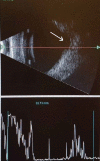Morning Glory Disc Anomaly with Contractile Peripapillary Staphyloma in an 18-Month-Old Girl
- PMID: 33762786
- PMCID: PMC7946035
- DOI: 10.1080/01658107.2020.1773507
Morning Glory Disc Anomaly with Contractile Peripapillary Staphyloma in an 18-Month-Old Girl
Abstract
We present an 18-month-old girl with strabismus and a variable esotropia of the left eye. Fixation of the affected eye was intermittent with a relative afferent pupillary defect. A fundus photography of the left eye displayed a combination of features of both morning glory disc anomaly and peripapillary staphyloma. A B-scan ultrasonography examination of the left eye showed a conical excavation of the posterior pole. Cycloplegic refraction measurements showed a large amount of anisometropia. Correction with glasses and part-time occlusion was prescribed and a strict follow-up routine was advised. No other systemic associations with the disease have been discovered so far in our patient. We support the theory that morning glory disc anomaly and peripapillary staphyloma may represent two different morphologies in the spectrum of the same disease.
Keywords: Morning glory disc anomaly; amblyopia; contractile staphyloma; esotropia.
© 2020 Taylor & Francis Group, LLC.
Figures




Similar articles
-
The morning glory disc anomaly: contractile movement, classification, and embryogenesis.Doc Ophthalmol. 1987 Apr;65(4):439-60. doi: 10.1007/BF00143047. Doc Ophthalmol. 1987. PMID: 3319466 Review.
-
Case Report: Fibroglial Retinal Tissue in Contractile Morning Glory Disc Anomaly.Case Rep Ophthalmol. 2021 Jun 11;12(2):525-530. doi: 10.1159/000510958. eCollection 2021 May-Aug. Case Rep Ophthalmol. 2021. PMID: 34248586 Free PMC article.
-
Unusual Trigger for Contractile Movements of Optic Disc in Peripapillary Staphyloma.J Curr Ophthalmol. 2022 Nov 30;34(3):369-372. doi: 10.4103/joco.joco_29_22. eCollection 2022 Jul-Sep. J Curr Ophthalmol. 2022. PMID: 36644460 Free PMC article.
-
Optic disk contractility in morning glory disk anomaly.J AAPOS. 2018 Apr;22(2):154-156. doi: 10.1016/j.jaapos.2017.10.017. Epub 2018 Feb 1. J AAPOS. 2018. PMID: 29410195
-
Postoperative follow-up of a case of atypical morning glory syndrome associated with persistent fetal vasculature.BMC Ophthalmol. 2019 Jul 16;19(1):150. doi: 10.1186/s12886-019-1154-6. BMC Ophthalmol. 2019. PMID: 31311513 Free PMC article. Review.
References
-
- Miller NR, Walsh FB, Hoyt WF, eds. Walsh and Hoyt’s Clinical Neuro-ophthalmology. Lippincott Williams & Wilkins; Vol. 1. 2005:59.
Publication types
LinkOut - more resources
Full Text Sources
